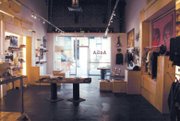AoSA: Retail With a Social Outreach
Owner Mike Hill talks about his new retail space, The AoSA Project in Huntington Beach, Calif., in a way that’s less about being a strategic retail business and more as if it’s a gallery-like showcase and community space that happens to sell what’s on display.
Hill’s mandatory criteria for earning floor space inside The AoSA Project is that the brand must have a component of “social outreach“ coupled with “rad” design.
“The store started from the need to showcase brands that do good work,” said Hill, who opened the doors on the first of September. “The word needs to be brought to the public in such a way where there’s a level of integrity, that the store itself has a giveback and is manned by people that have a similar vibe.”
Located behind the retail front is Hill’s printing company, AoSA Image, which specializes in trade show booth displays; point-of-purchase displays, signage and banners; and textile printing using eco-friendly inks and on recyclable, recycled, salvaged or domestically sourced goods. AoSA Image’s new, larger space is quickly filling up with piles of salvaged materials that will be divvied up for Hill’s clients’ projects and into the retail store, in which 85 percent to 90 percent of the furniture is made from salvage. Each brand is featured in its own shop-in-shop space made by Hill’s team of junkyard scavengers with signage that explains its humanitarian story.
The huge build-out for 31 Bits jewelry (made by displaced women in Uganda) is a collage of dyed linen, stained construction blocking, natural canvas and railroad spikes. The blocking was left over from a construction job at UC Irvine, and the canvas was repurposed from a previous job for Toms shoes, which are also sold in the store. Jedidah (which partners with a different nonprofit each season) has a shop-in-shop made from driftwood.
The shop also stocks Yellow 108 accessories, Obey clothing and Krochet Kids hats,all of which have charitable arms. “I do a lot of the visual merchandising for [some of] the brands, so I don’t feel out of my element,” Hill said.
Defining a lounging space in the back of the shop is an L-shaped sofa that was upholstered from remaindered denim fabric turned inside out, courtesy of Hill’s sewer. Surrounding the sofa, glass dividers (shower doors headed for the dumpster by a neighboring glassmaker) are printed with a pretty, circular pattern. In this living room–like area, Hill plans to host workshops inspired by The Ecology Center in San Juan Capistrano, Calif., an educational center that hosts family-oriented, hands-on activities about eco-friendly, sustainable living.
So far the scheduled “kindergarten-style,” how-to class topics held at The AoSA Project include bead making, stained-glass work and egg carving taught by local artists.
“The audience we have here is high schoolers or old ladies. We’re trying to make kids enjoy the experience of playing and to make them feel like they can create something hellip; get out and start your own thing,” Hill said.
Some visitors to the store are skeptical about merchandise’s socially responsible claims, but Hill stands behind his brands. “I know the individuals and the brands, and I feel that what they do stems from the want to help people,” he said.—R.C.






















